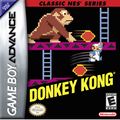Classic NES Series: Difference between revisions
No edit summary |
|||
| Line 14: | Line 14: | ||
*'''''[[Super Mario Bros.: The Lost Levels|Super Mario Bros. 2]]''''' – Released on August 10, 2004. Known as ''Super Mario Bros.: The Lost Levels'' in the West. | *'''''[[Super Mario Bros.: The Lost Levels|Super Mario Bros. 2]]''''' – Released on August 10, 2004. Known as ''Super Mario Bros.: The Lost Levels'' in the West. | ||
*'''''[[Wrecking Crew]]''''' – Released on May 21, 2004. | *'''''[[Wrecking Crew]]''''' – Released on May 21, 2004. | ||
==Criticism== | |||
*The Bomberman game was criticized for its lack of a multiplayer mode | |||
*The Donkey Kong game was criticized for the lack of the "pie factory", which was actually omitted from the NES release | |||
*The high price was criticized by consumers due to the significantly lower price of the [[e-Reader]] releases. | |||
==Trivia== | |||
*The arcade ports such as Donkey Kong and Pac Man have a "save high score" feature added, which the NES was unable to do. | |||
*Various popular games were omitted due to their previous releases on the GBA. | |||
**Tetris had already been released as Tetris Worlds. | |||
**[[Super Mario Bros. 2]] had already been released as [[Super Mario Advance]] | |||
**[[Super Mario Bros. 3]] had already been released as [[Super Mario Advance 4]] | |||
**[[Mario Bros.]] had already been released on every [[Super Mario Advance]] title. | |||
*The glitches from Super Mario Bros. and the poorly-written intro to The Legend of Zelda were fixed in the re-release. | |||
==Gallery== | ==Gallery== | ||
Revision as of 00:41, March 15, 2010
The Classic NES Series, known as the NES Classics in Europe and as Famicom Mini in Japan, is a series of video games for the Game Boy Advance released in 2004 and 2005. All games are emulated versions of classic NES/Famicom video games, including six games of the Mario series. They are mostly unchanged from the originals, but features such as multiplayer using the link cable (only if the original game included multiplayer) and save functions for high scores and custom levels were added in certain cases. The resolution of the games was altered to fit the GBA screen, making the graphics look "squished."
In Japan, Nintendo released 29 games in three series in total, while North America and Europe only saw 12 games in two series. Several NES games were also released in North America on e-Reader cards, though. The Japanese releases feature game packaging almost identical to the original packaging for the Famicom.
One notable change is the ability to save high scores, which the NES was unable to do.
Mario Games
Mario games released internationally:
- Donkey Kong – Released on on February 14, 2004 in Japan, on June 7, 2004 in North America, and on July 9, 2004 in Europe. Notably, this game does not include the "pie factory" level, a level exclusive to the arcade version of the game.
- Dr. Mario – Released on May 21, 2004 in Japan, on October 25, 2004 in North America, and on January 7, 2005 in Europe.
- Super Mario Bros. – Released on February 14, 2004 in Japan, on June 7, 2004 in North America, and on July 9, 2004 in Europe. On September 13, 2005, it was re-released in Japan on the occasion of the game's 20th anniversary.
Mario games released in Japan only:
- Mario Bros. – Released on May 21, 2004.
- Super Mario Bros. 2 – Released on August 10, 2004. Known as Super Mario Bros.: The Lost Levels in the West.
- Wrecking Crew – Released on May 21, 2004.
Criticism
- The Bomberman game was criticized for its lack of a multiplayer mode
- The Donkey Kong game was criticized for the lack of the "pie factory", which was actually omitted from the NES release
- The high price was criticized by consumers due to the significantly lower price of the e-Reader releases.
Trivia
- The arcade ports such as Donkey Kong and Pac Man have a "save high score" feature added, which the NES was unable to do.
- Various popular games were omitted due to their previous releases on the GBA.
- Tetris had already been released as Tetris Worlds.
- Super Mario Bros. 2 had already been released as Super Mario Advance
- Super Mario Bros. 3 had already been released as Super Mario Advance 4
- Mario Bros. had already been released on every Super Mario Advance title.
- The glitches from Super Mario Bros. and the poorly-written intro to The Legend of Zelda were fixed in the re-release.
Gallery
- CNS-SMB Cover.jpg
- CNS-DMario.jpg
- FM Mario Bros JAP cover.jpg
- FM Wrecking Crew JAP cover.jpg
- FM Super Mario Bros 2 JAP cover.jpg
External Links
- Official European Website
- Official Japanese Website
